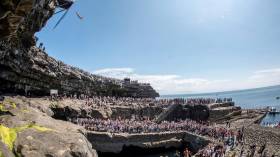Displaying items by tag: Poll na Péist
Two Italian brothers rescued after they were knocked into the sea in the Aran Islands have returned to meet the coastguard crew who saved them.
In February 2019, Giovanni and Ricardo Zanon were struck by an unexpected wave at Poll na bPéist on Inis Mór, falling 20 metres off the cliff into the cold Atlantic.
Despite sustaining serious injury — Ricardo Zanon broke his tibia and pelvis in the fall — the brothers survived to tell the tale thanks to the swift actions of the crew of the Irish Coast Guard’s Shannon-based helicopter Rescue 115.
As previously reported on Afloat.ie, Rescue 115’s winchman Philip Wrenn won a prestigious award earlier this year for his role in the rescue.
The Zanon brothers and their parents returned to Inis Mór today (Wednesday 11 August) for the first time since the incident to give thanks to Wrenn and the rest of the crew.
Speaking to RTÉ’s Morning Ireland, Ricardo said of that fateful day: “I just remember a big, huge wave like a grey wall coming towards me and then it was completely dark and I thought I was going to die.”
RTÉ News has more on the story HERE.
Greg Louganis Set For Red Bull Cliff Diving On Inis Mór
#CliffDiving - World famous Olympic diver Greg Louganis will attend the Red Bull Cliff Diving World Series event in the Aran Islands later this month as the competition’s new sports director, as Galway Bay FM reports.
The five-time world champion and four-time Olympic gold medallist will arrive on the island of Inis Mór ahead of the globe’s cliff diving elite, who make their return to Poll na Péist — also known as the Serpent’s Lair — on the first stop of this year’s world tour, as previously reported on Afloat.ie.
All tickets for live spectators have been snapped up for the contest on Saturday 24 June, but the action will be livestreamed online via Red Bull TV.
Cliff Diving World Series Returns To Aran Islands In 2017
#CliffDiving - The Red Bull Cliff Diving World Series returns to Poll na Péist this summer, as the Offaly Express reports.
Also known at the Serpent’s Lair, the spectacular blowhole in the Aran Islands last hosted cliff diving’s top flight in June 2014.
Saturday 24 June will mark the third visit of the global tour to the islands since 2012, and is just one of six stops worldwide in the 2017 competition.
Reigning men’s and women’s champs Gary Hunt from the UK and Australia’s Rhiannan Iffland are expected to lead the cream of the sport to Inis Mór for the first stage of the new season before stops in Portugal, Italy, Texas, Bosnia and Chile.
The Offaly Express has more on the story HERE.






























































